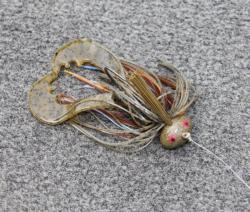Football season
Multiple looks, multiple tactics keep football-head jigs productive year round
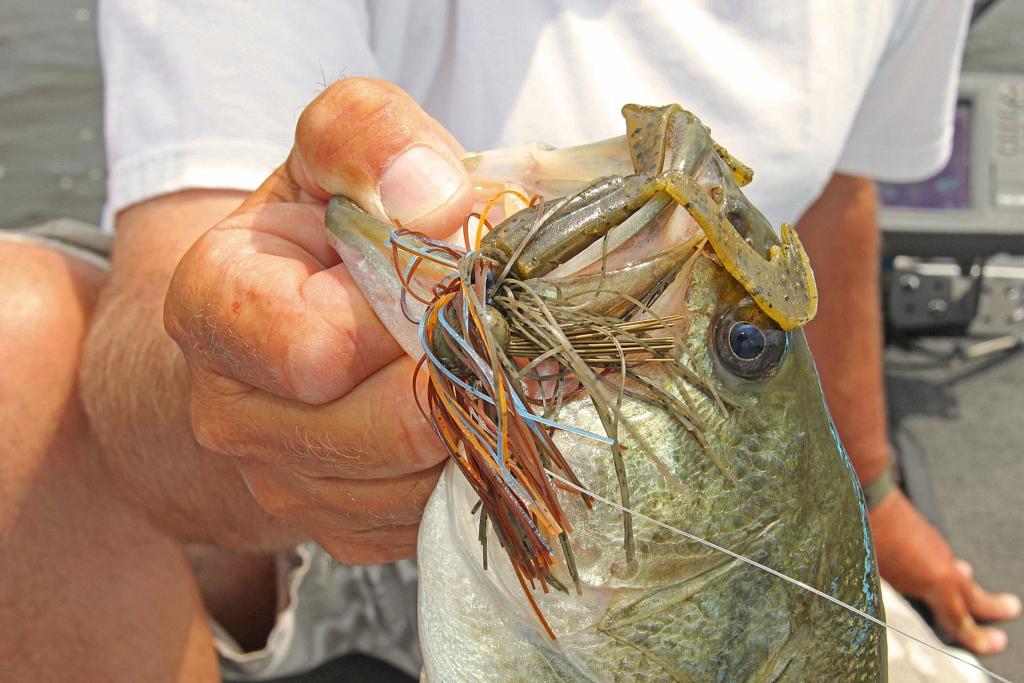
NFL playoffs are just around the corner. But flash forward a few weeks from now and football fans may be feeling a bit of a letdown while sweeping up after those Super Bowl parties. However, unlike their gridiron counterparts, bass anglers know that their football – specifically, the football-head jig – will remain a relevant part of their lives year-round.
Much more than a lumbering bottom bumper, the football jig offers a diverse tool for probing those deeper spots – especially those with lots of hard stuff on the bottom. Designed to work its way across uneven surfaces with less chance of snagging, the football-head jig can indeed serve as a clunky wake-'em-up tool, an in-your-face reaction bait or a highly effective finesse tactic.
FLW Tour pro Jim Moynagh helped All-Terrain Tackle design his signature Rock Jig – a bare football head, and a weed guard model. Moynagh finds a weed-guarded jig most universal on reservoirs, as river systems accumulate loads of debris – including such things as old fishing line, brush piles, abandoned trot lines, etc. Natural lakes, however, typically present less cluttered bottoms, so you can get away without a brush guard.
Moynagh's signature jig sports a knobby "Terrain Tread" underside that breaks up the big object's profile and creates multiple sensitivity spots for reading the bottom. This distant perception is a key attribute with any football model.
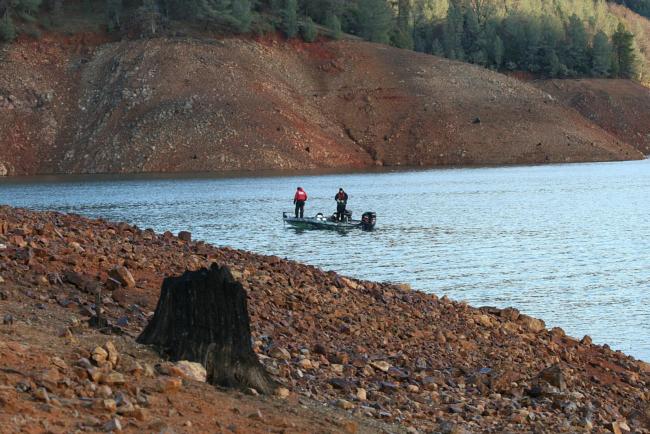 "Knowing the type of bottom is vital in trying to put together a bass pattern," Moynagh said. "Bass tend to be attracted to hard bottom – gravel, shell beds or rock – so knowing where they are obviously determines how many fish you're going to catch. This type of jig is perfect for helping your determine if the bottom is muck, soft sand, big boulders or something in between like gravel.
"Knowing the type of bottom is vital in trying to put together a bass pattern," Moynagh said. "Bass tend to be attracted to hard bottom – gravel, shell beds or rock – so knowing where they are obviously determines how many fish you're going to catch. This type of jig is perfect for helping your determine if the bottom is muck, soft sand, big boulders or something in between like gravel.
"It helps you locate the edges (of hard habitat), or just a little detail," Moynagh continued. "You might be fishing a gravel bar or a big shell bed and then one little area might have a little rock pile. With a fooball jig, you can feel that (subtle difference) instantly. Those are the kinds of things you have to find when you're looking for schooling fish on deep structure."
Chevy pro Dion Hibdon agrees while underscoring the football jig's time-management benefit.
"It's a fast way of (searching)," said Hibdon. "You make a long cast, let it hit the bottom and start working it. If I don't feel anything really firm, if it's not crisp, I keep working it along until I hit something that's more solid. That's how you find those little shell beds out there on those river humps and little rocky places out on any given lake you're fishing.
"You can only see so much on those depth finders and they'll show you a rocky place sometimes," Hibdon said. "But the only way I know for sure on a lake like Kentucky Lake that I'm on a shell bed is to feel around for them with my bait. It's all about finding those sweet spots."
Diverse tactics
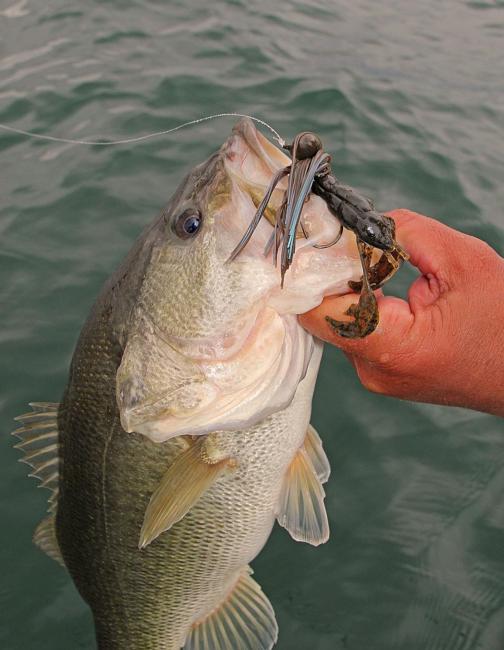 For some, the football head has replaced the Carolina rig for covering broad areas and searching out active fish – sans the occasional snagging hazard of a bait trailing on a leader. Contrast that with the football head's all-in-one package, which rumbles its way into, across and over just about anything the bottom offers.
For some, the football head has replaced the Carolina rig for covering broad areas and searching out active fish – sans the occasional snagging hazard of a bait trailing on a leader. Contrast that with the football head's all-in-one package, which rumbles its way into, across and over just about anything the bottom offers.
College Fishing standout Danny Iles also likes the football head's ability to extend his reach when he exhausts the limits of a deep-diving crankbait.
"Up to a point, a crankbait is probably the best bait to read the bottom, but once you're deeper than, say 15 feet, it really gets hard to figure out what's going on down there with a crankbait. But with a big football jig, you can fish a whole lot deeper and still get a good feel for the bottom and exactly what's down there."
Moynagh said his No. 1 football head tactic is probing deep structure during the post-spawn period with a 3/4-ounce jig. On the lighter end, he likes fishing a 3/8- to 1/2-ounce model around docks with no weeds – a year-round option, depending on geography.
During the pre-spawn, he'll work sharp, bluff banks with a 3/8- to 3/4-ounce football jig depending on depth. He'll throw the jig up shallow and work it down the edge in search of fish staging outside the flats or coves in which they'll soon spawn.
"They'll be on the steepest shorelines of the creek arms or the main lake," Moynagh said. "Depending on the fishery, they can be up in 1 to 5 feet of water. Other times, I've caught them down as deep as 40."
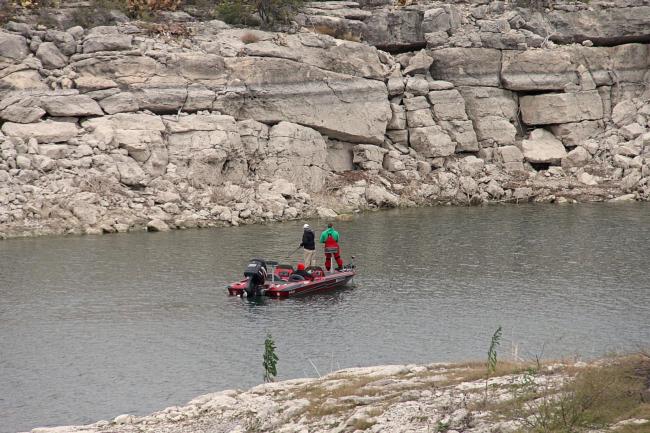
For Iles, purpose determines retrieval speed. If he's searching, he keeps his jig moving fairly quickly. But once he locates fish or fishy structure, he'll slow down and focus his efforts.
"You can either drag slow and steady like a Carolina rig or you can give it two or three little twitches and then scoot it across the bottom," Iles said of his search strategy. "The No. 1 thing I do when I find fish in cold or warm water is I drag the football jig into where they are and just let it sit – it's kind of like dead-sticking a Senko.
"If I'm 100-percent sure there's a fish there and my bait's in the right spot, I might let it sit a minute or a minute and a half before I move it," said Iles. "I feel like if you get it in the right spot and they sit there and look at it, they just maybe come a little closer. When you drag it just a little bit and it does something different, that's what makes them bite."
Along those lines, don't hesitate to stroke that football head with sharp rod work and a freefall motion on slack line. This sudden rise and crash is often just the thing to trigger a reaction strike, but keep this tactic for open water, otherwise you'll hang a lot of jigs. Kellogg's Rice Krispies Treats pro Jim Tutt said a scaled-down package is also helpful when stroking a football jig for fish holding a little off the bottom. He wants his jig to fall quickly past their face, so he'll go with a short trailer, or trim an inch off the body of a longer bait.
Football heads can accommodate just about any soft plastic trailer you choose, but Iles breaks it down this way: "It's not so much the exact color or trailer but the general theme. Is it something that's going to flap around a bunch, is it something that's going to more or less just glide around to the bottom and sit still like a chunk, or is it going to kick like a Strike King Rage Craw.
"In crystal clear water you have to pay more attention to color, but if you stick with a couple of basic colors and a couple of trailer styles – a chunk and something that kicks, you can at least get in the right area to get a few bites and then you can fine-tune from there."
Hibdon mostly throws a 1-ounce Luck-E-Strike Enticer football head and maintains modest presentations during cold weather – with a twin tail or simple craw trailer that emits lifelike motion with minimal jig movement. In warmer conditions, he'll switch to more lively trailers like a NetBait Paca Craw, Berkley Chigger Craw, Yamamoto Double Tail Hula Grub and others with more inherent movement.
Moynagh keeps his trailer options simple – he goes with either a twin tail or swimming style body (a Zoom Speed Craw for example) with color options matched to the local water color and forage bass. Alternating looks can keep a bite going.
"I'll have both rigged up and I just try to determine if one is preferred on a given day," he said. "If I'm on a school of fish, I like to show the fish something different. I'll throw the jig with one (trailer style) for a while and if the bite slows down, I'll throw the other one out there. Usually I can pick up a few more on a jig that's slightly different."
Vary the presentations
Here are a few ideas for further diversifying your football-head presentations:
Color it up: Experimenting with skirt color combinations can trigger strikes from curious bass. When Glen Freeman won the EverStart Texas Division event on Toledo Bend in early June, a football head played a key role in his game plan. He enhanced a green pumpkin skirt by adding a few strands of purple to mimic natural bluegill tones.
Barreling forward: In early 2012, Walmart FLW Tour pro Tim Gaskill's Toad Products introduced the Shakey Barrel Head Jig in sizes 1/8- to 3/4-ounce. The jig's cylindrical head offers even greater bottom contact and a posture that's guaranteed to hook fish in the roof of the mouth.
Work the wiggle: ICAST 2012 saw Freedom Tackle introduce a lineup of jigs with an interchangeable hook design that moves independently of the jig head for maximum motion and minimal hook throwing. Pairing this with an active trailer like the Berkley Havoc Hawk Hawg delivers a dynamic presentation that's very effective when searching for active fish – especially pre-spawners looking to fill their bellies.
Thump it: Brian Maloney topped the 2012 BFL All-American on the Potomac River by working a football head through ditches where bass retreated on falling tides. Timing the water's movement was important, but so was his choice of plastic. On his 5/16-ounce football head jig, Maloney used a Garneau Baits Slap Stick hand-poured paddle tail worm, which emitted the thump and vibration that triggered aggressive bites.
Lighten up: Texas pro Cody Bird likes a 3/16-ounce head with a Kicker Fish High Tail Hole Shot worm because the bait's holes trap air and that makes it stand up for a lively presentation. Bird said this is a killer presentation on steep bluff ends for spotted bass on lakes like Beaver and Table Rock. Violent rod shakes on slack like, he said, will walk the bait down the slope and spots can't stand it.
All of these presentations and the countless variations of each represent a diverse playbook of bass tactics in which the football head remains your marquis player.
